“The Last Question” by Isaac Asimov is a science fiction short story first published in 1956. The ideas are even more relevant today than they were back in the 1950s.
Isaac Asimov was an ideas man. I generally find his work hard to read because I read for character first. Asimov worked the other way around — he created characters to convey his ideas. Asimov was able to visualise all sorts of futures, but not a future of gender equality. However, this one is accessible to a wider audience.
“The Last Question” concerns the fallacy of the magic porridge pot. Based on the fairytale, this is the idea that there’s a never-ending supply of everything. By extension, if one group draws heavily from a particular resource, they are able to reason, happily for themselves, that they are not simultaneously taking away from someone else. The ‘someone else’ might be a disadvantaged group in the present. In the case of this story, the ‘someone else’ is future generations.
Another modern term related to the ideas in “The Last Question” is ‘Techno-Jesus’ — the idea that technology is going to save us all (from climate change etc.) We’ll get another Steve Jobs, so don’t worry.
This makes “The Last Question” particularly relevant to today. Interesting that even back in the 1950s, these ideas were considered. Already, back then, some people — especially Americans, perhaps — could see that all this increase in consumption could not go on forever.
Importantly, this was Isaac Asimov’s favourite of all the short stories he wrote. Asimov liked it best for two reasons:
- He wrote it in a ‘white heat’, and it required hardly any modification after the first draft.
- “The Last Question” proved to be the most resonant for his readers. Once you’ve read this story, you won’t forget the main idea.
STORY STRUCTURE OF “THE LAST QUESTION”
The ‘main character’ of this story is ‘humanity’. But even an ideas man needs the usual character web of opposition and allies. Because Asimov was not especially interested in individuals, he used the 20th century default to people his worlds — men. Women were needed occasionally as powerless children, wives, mothers and sexual interest.
SHORTCOMING
The shortcoming of a technologically advanced humanity is that we grow increasingly reliant upon technology to the point where we don’t understand it.
The shortcoming of an ever expanding civilisation is that we are propelled forth even against our will to grow bigger and bigger, go further and further.
DESIRE
To expand. To not die.
OPPONENT
Entropy.
But for story purposes, Asimov sets up conversations in which two characters disagree with each other… until he doesn’t. Then it’s computer against the two human characters, and finally there is no conflict because everything has become one.
PLAN
Humans do their utmost to preserve their immortality. They even go so far as to create new planets from dust and turn them into massive computers.
BIG STRUGGLE
Each vignette summarises a part of the over-arching Battle against entropy. By the end of each vignette, it is clear that the humans have progressed in one way, but still lost the big struggle.
ANAGNORISIS
The revelation, for each of these characters in each of the vignettes—and therefore for the reader—is that there’s no getting around the fact: Humans will never, ever last forever. No matter what we do, entropy is more powerful than all of us.
NEW SITUATION
There is nothing. But because the final sentence is reminiscent of Biblical language, any reader familiar with the major religions will recognise that this is also the beginning of some new universal cycle. We assume this plays out over and over and over for infinity
EXTRAPOLATION
Next time round, it’s highly unlikely mammals such as humans will reign supreme. It was pretty much a fluke in the first place.

